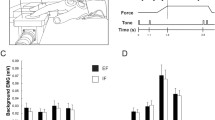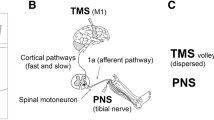Abstract
Surround inhibition is a physiological mechanism to focus neuronal activity in the central nervous system. This so-called center-surround organization is well known in sensory systems, where central signals are facilitated and eccentric signals are inhibited in order to sharpen the contrast between them. There is evidence that this mechanism is relevant to skilled motor behavior, and it is deficient, for example, in the affected primary motor cortex of patients with focal hand dystonia (FHD). While it is still not fully elucidated how surround inhibition is generated in healthy subjects, the process is enhanced with handedness and task difficulty indicating that it may be an important mechanism for the performance of individuated finger movements. In FHD, where involuntary overactivation of muscles interferes with precise finger movements, a loss of intracortical inhibition likely contributes to the loss of surround inhibition. Several intracortical inhibitory networks are modulated differently in FHD compared with healthy subjects, and these may contribute to the loss of surround inhibition. Surround inhibition can be observed and assessed in the primary motor cortex. It remains unclear, however, if the effects are created in the cortex or if they are derived from, or supported by, motor signals that come from the basal ganglia.





Similar content being viewed by others
References
Alexander GE, DeLong MR, Strick PL (1986) Parallel organization of functionally segregated circuits linking basal ganglia and cortex. Annu Rev Neurosci 9:357–381
Andersen P, Hagan PJ, Phillips CG, Powell TP (1975) Mapping by microstimulation of overlapping projections from area 4 to motor units of the baboon’s hand. Proc R Soc Lond B Biol Sci 188:31–36
Angelucci A, Levitt JB, Lund JS (2002) Anatomical origins of the classical receptive field and modulatory surround field of single neurons in macaque visual cortical area V1. Prog Brain Res 136:373–388
Baker SN, Olivier E, Lemon RN (1998) An investigation of the intrinsic circuitry of the motor cortex of the monkey using intracortical microstimulation. Exp Brain Res 123:397–411
Bara-Jimenez W, Catalan MJ, Hallett M, Gerloff C (1998) Abnormal Somatosensory Homunculus in Dystonia of the hand. Ann Neurol 44(5):828–830
Beck S, Hallett M (2010) Surround inhibition is modulated by task difficulty. Clin Neurophysiol 121(1):98–103
Beck S, Pirio Richardson S, Shamim EA, Dang N, Schubert M, Hallett M (2008) Short intracortical and surround inhibition are selectively reduced during movement initiation in focal hand dystonia. J Neurosci 28(41):10363–10369
Beck S, Shamim EA, Pirio Richardson S, Schubert M, Hallett M (2009a) Interhemispheric inhibition contributes to reduced surround inhibition in dystonia. Eur J Neurosci 29(8):1634–1640
Beck S, Schubert M, Richardson SP, Hallett M (2009b) Surround inhibition depends on the force exerted and is abnormal in focal hand dystonia. J Appl Physiol 107(5):1513–1518
Beck S, Houdayer E, Pirio Richardson S, Hallett M (2009c) Premotor-motor inhibition is increased at rest in patients with focal hand dystonia. Brain Stimul 2(4):208–214
Blakemore C, Carpenter RH, Georgeson MA (1970) Lateral inhibition between orientation detectors in the human visual system. Nature 228:37–39
Chen R, Kumar S, Garg RR, Lang AE (2001) Impairment of motor cortex activation and deactivation in Parkinson’s disease. Clin Neurophysiol 112:600–607
Collins R (1978) Use of cortical circuits during focal penicillin seizures: an autoradiographic study with [14C] Deoxyglucose. Brain Res 150:487–501
Conte A, Gilio F, Iezzi E, Frasca V, Inghilleri M, Berardelli A (2007) Attention influences the excitability of cortical motor areas in healthy humans. Exp Brain Res 182(1):109–117
Denny-Brown D (1967) The fundamental organization of motor behavior. In: (Yahr M, Purpura D et al (eds) Neurophysiological basis of normal and abnormal motor activities. Raven, New York, pp 415–442
Duque J, Murase N, Celnik P, Hummel F, Harris-Love M, Mazzoccio R, Olivier E, Cohen LG (2007) Intermanual Differences in movement-related interhemispheric inhibition. J Cogn Neurosci 19:204–213
Ferbert A, Priori A, Rothwell JC, Day BL, Colebatch JG, Marsden CD (1992) Interhemispheric inhibition of the human motor cortex. J Physiol 453:525–546
Godaux E, Koulischer D, Jacquy J (1992) Parkinsonian bradykinesia is due to depression in the rate of rise of muscle activity. Ann Neurol 31:93–100
Graybiel AM, Aosaki T, Flaherty AW, Kimura M (1994) The basal ganglia and adaptive motor control. Science 265:1826–1831
Hallett M (2003) Surround inhibition. Suppl Clin Neurophysiol 56:153–159
Hallett M (2004) Dystonia: abnormal movements result from loss of inhibition. Adv Neurol 94:1–9
Hallett M (2006) Pathophysiology of writer’s cramp. Hum Mov Sci 25:454–463
Hallett M, Khoshbin S (1980) A physiological mechanism of bradykinesia. Brain 103:301–314
Hoover JE, Strick PL (1993) Multiple output channels in the basal ganglia. Science 259:813–821
Huntley GW, Jones EG (1991) Relationship of intrinsic connections to forelimb movement representations in monkey motor cortex: a correlative anatomic and physiological study. J Neurophysiol 66:390–413
Jedynak PC, Tranchant C, de Beyl DZ (2001) Prospective clinical study of writer’s cramp. Mov Disord 16:494–499
Kujirai T, Caramia MD, Rothwell JC et al (1993) Corticocortical inhibition in human motor cortex. J Physiol (Lond) 471:501–519
Landgren S, Phillips CG, Porter R (1962) Cortical fields of origin of the monosynaptic pyramidal pathways to some alpha motoneurones of the baboon’s hand and forearm. J Physiol 161:112–125
Liepert J, Classen J, Cohen LG, Hallett M (1998) Task-dependent changes of intracortical inhibition. Exp Brain Res 118:421–426
Mink JW (1996) The basal ganglia: focused selection and inhibition of competing motor programs. Prog Neurobiol 50:381–425
Murase N, Duque J, Mazzoccio R, Cohen LG (2004) Influence of interhemispheric interactions on motor function in chronic stroke. Ann Neurol 55:400–409
Nauta WJH, Mehler WH (1966) Projections of the Ientiforrn nucleus in the monkey. Brain Res 1:3–42
Parent A, De Bellefeuille L (1982) Organization of efferent Projections from the internalsegment of globus pallidus in primate as revealed by a fluorescenceretrograde labelling method. Brain Res 245:201–213
Pirio Richardson S, Bliem B, Voller B, Dang N, Hallett M (2009) Long-latency afferent inhibition during phasic finger movement in focal hand dystonia. Exp Brain Res 193:173–179
Quartarone A, Bagnato S, Rizzo V, Siebner HR, Dattola V, Scalfari A, Morgante F, Battaglia F, Romano M, Girlanda P (2003) Abnormal associative plasticity of the human motor cortex in writer’s cramp. Brain 126(Pt 12):2586–2596
Richardson SP, Bliem B, Lomarev M, Shamim EA, Dang N, Hallett M (2008) Changes in short afferent inhibition during phasic movement in focal dystonia. Muscle Nerve 37(3):358–363
Sabatini U, Boulanouar K, Fabre N, Martin F, Carel C, Colonnese C et al (2000) Cortical motor reorganization in akinetic patients with Parkinson’s disease: a functional MRI study. Brain 123:394–403
Schieber MH (1991) Individuated finger movements of rhesus monkeys: a means of quantifying the independence of the digits. J Neurophysiol 65:1381–1391
Schieber MH, Hibbard LS (1993) How somatotopic is the motor cortex hand area? Science 261:489–492
Schieber MH, Poliakov AV (1998) Partial inactivation of the primary motor cortex hand area: effects on individuated finger movements. J Neurosci 18:9038–9054
Schneider C, Devanne H, Lavoie BA, Capaday C (2002) Neural mechanisms involved in the functional linking of motor cortical points. Exp Brain Res 146:86–94
Shin HW, Kang SY, Sohn YH (2007) Disturbed surround inhibition in preclinical parkinsonism. Clin Neurophysiol 118:2176–2179
Shin HW, Sohn YH, Hallett M (2009) Hemispheric asymmetry of surround inhibition in the human motor system. Clin Neurophysiol 120:816–819
Sohn YH, Hallett M (2004a) Disturbed surround inhibition in focal hand dystonia. Ann Neurol 56:595–599
Sohn YH, Hallett M (2004b) Surround inhibition in human motor system. Exp Brain Res 158:397–404
Stefan K, Kunesch E, Cohen LG, Benecke R, Classen J (2000) Induction of plasticity in the human motor cortex by paired associative stimulation. Brain 123(Pt 3):572–584
Stinear CM, Byblow WD (2004) Impaired modulation of intracortical inhibition in focal hand dystonia. Cereb Cortex 14:555–561
Tamburin S, Manganotti P, Marzi CA, Fiaschi A, Zanette G (2002) Abnormal somatotopic arrangement of sensorimotor interactions in dystonic patients. Brain 125:2719–2730
Tamburin S, Fiaschi A, Andreoli A, Marani S, Zanette G (2005) Sensorimotor integration to cutaneous afferents in humans: the effect of the size of the receptive field. Exp Brain Res 167(3):362–369
Tinazzi M, Priori A, Bertolasi L, Frasson E, Mauguiere F, Fiaschi A (2000) Abnormal sensory integration of a dual somatosensory input in dystonia. Brain 123:42–50
Weise D, Schramm A, Stefan K, Wolters A, Reiners K, Naumann M, Classen J (2006) The two sides of associative plasticity in writer’s cramp. Brain 129:2709–2721
Zatsiorsky VM, Li ZM, Latash ML (2000) Enslaving effects in multifinger force production. Exp Brain Res 131:187–195
Zehr EP, Stein RB (1999) Interaction of the Jendrassik maneuver with segmental presynaptic inhibition. Exp Brain Res 124:474–480
Ziemann U (2004) TMS and drugs. Clin Neurophsiol 115:1717–1729
Ziemann U, Rothwell JC, Ridding MC (1996) Interaction between intracortical inhibition and facilitation in human motor cortex. J Physiol 496(3):873–881
Acknowledgments
Work supported by the NINDS Intramural Program.
Author information
Authors and Affiliations
Corresponding author
Rights and permissions
About this article
Cite this article
Beck, S., Hallett, M. Surround inhibition in the motor system. Exp Brain Res 210, 165–172 (2011). https://doi.org/10.1007/s00221-011-2610-6
Received:
Accepted:
Published:
Issue Date:
DOI: https://doi.org/10.1007/s00221-011-2610-6




